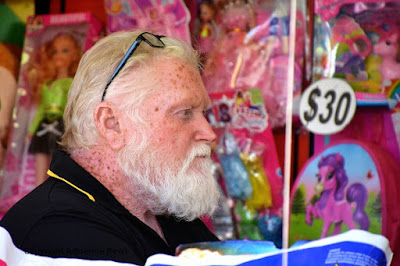Long before I
ever reached Coober Pedy on my recent road trip from Melbourne to Darwin, I had
received plenty of advice:
“Don’t go near
the place, it’s a hole!”
“What do you
want to go THERE for?”
“Dreadful place
– not worth your time.”
“I can’t
understand why anyone would want to live there!”
And so on.
I knew as soon
as soon as I saw the first sign of opal mines on that vast, unending landscape,
that I was probably wrong – that really, it could only be the possibility of
striking it rich in opal mining that would bring people to such a desolate and
dusty place. There was nothing but salt bush and red dirt for as far as the eye
could see – and, as we got closer to Coober Pedy itself, there were also the
giant earth mounds and a skyline full of cranes.
We arrived at
Coober Pedy township at around 3pm on July 2. It was 17-degrees, sunny and very
glary. The skyline was dominated by huge wind turbines, piles of dirt, solar
panels and mining operations. A cluster of scruffy buildings lined both sides
of the ‘main street’ and dazed-looking tourists wandered about in their droves.
They had the look of people who thought themselves lost, that perhaps they had
missed the turn off to the ‘real’ Coober Pedy’ and had instead, found
themselves in this broken-down, dusty little ‘wild west’ film set. Even the
giant Coober Pedy sign on the hill, mimicking its Hollywood counterpart, didn’t
seem to put them at ease.
With only a few
hours of daylight left to explore, we checked into our Underground Motel – for
what is a stay in Coober Pedy without a sleep in an underground bed? – and
headed for ‘the sights.’ To be honest, they took a bit of finding.
The first
underground church we visited was empty and a little characterless, so we
headed out of town to the Serbian Orthodox Church of the Holy Prophet Elijah.
We eventually found it at the end of a dusty road, surrounded by mines – an
impressive exterior façade, carved into a huge bank of solid rock. Construction began in 1992 and was completed
in 1993.
The whole
complex houses a church, community hall, religious school and parish house, and
varies in depth from 3 metres to 17 metres underground. It has impressive stained
glass and deep within the church itself, there’s a cool sense of calm - an
obliviousness of the barren outside world that I found rather pleasing.
Apparently more tourists visit the church than there are parishioners but apart
from an avid amateur photographer who was determined to teach us all he knew,
there wasn’t a soul about; and the Mediterranean style garden that the
parishioners had tried to grow amounted to little more than a few beaten
oranges and some wispy olive and pomegranate trees.
It turns out -
not surprisingly – that very little grows in Coober Pedy. Between the low
rainfall, the high cost of water, the solid sandstone and the lack of topsoil,
plants don’t really stand a chance. The fact that the whole place is surrounded
by stony treeless desert, is probably a pretty good hint.
Coober Pedy is
small – between 1,762people (2016) and perhaps 2,500. It is known as a the Opal
Capital of the World – given that it supplies most of the world’s gem-quality
opals and that it has over 70 opal fields and the largest opal mining area in
the world. None of that does anything to beautify the area. The ‘normal’ above
ground housing stock was minimal and ‘wanting’ and with summer temperatures
heading well over the 40-degree mark, the stable coolness of an underground
dwelling would likely be much more appealing. Little ‘chimney air vents’ poking
up out of all this hills, hinted at dozens of underground homes, offices and
accommodation providers.
After a quick
foray into the Umoona Mining Museum and Shop (very well done), I’d seen enough
about opals to last me, so we headed for the Underground Bar at the Desert Cave
Hotel. I found myself as puzzled and dazed as any other tourist around me – was
I in the right place? Could this be it? In short, it was a completely wasted
opportunity to make something quite special. Instead, their crowning glory
appeared to be “The Only Underground Poker Gaming Machines in the World.”
To make matters
worse, the recommended Chinese restaurant down the road was closed. The Bar and
Grill was packed with people and holidaying kids. The Greek restaurant was
closed and the Pizza Bar was overflowing onto the street. So it was dinner at
Coober Pedy’s most expensive restaurant – I vaguely remember Atlantic Salmon.
Tasty as it turned out.
We were aiming
for Uluru the next day (a 10-hour drive), so we were out of our underground motel before dawn and
on the road. All up, we had about six hours awake in Coober Pedy – although one
could be forgiven for thinking it was all a dream.
But for me, it
comes down to one thing – would I go back? And the answer is, yes. Six hours wasn’t enough for me to get the
photographs I wanted, nor to talk to some of the people who call Coober Pedy
home. That would have been the most interesting thing of all for me. Because
there sure as hell isn’t too much else about the place to recommend it.



























































